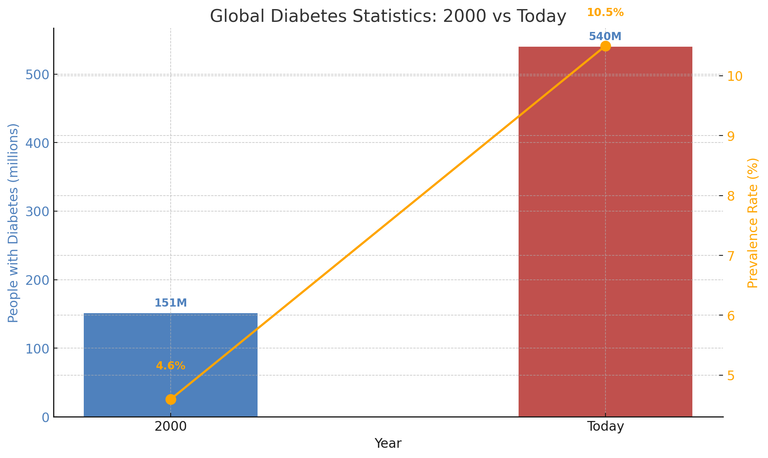Understanding Diabetes- Understanding the Numbers

Not everyone will get diabetes in their lifetime. It might feel unfair, but it’s a reality. Back when very little was known about diabetes, people could only cross their fingers and hope they’d escape it. But today, we’ve made tremendous progress, and medical advances now let us predict who’s more likely to develop diabetes based on risk factors.
In fact, online tools allow people to enter a few details and get a personal risk assessment. But before diving into these risk factors, let’s put the scale of diabetes into perspective. You probably know diabetes is common, but sometimes seeing the numbers clarifies just how widespread it is.
Diabetes prevalence varies by location. Some regions have more cases, while others have fewer. What’s clear is that diabetes has become an epidemic, with numbers rising sharply compared to the start of the century.
Here’s a bar chart I had drawn using AI tools, showing this increase. The blue bar represents the number of people with diabetes worldwide in 2000, and the red bar shows today’s figure.

In 2000, around 4.6% of the world’s population had diabetes. Today, that number has jumped to 10.5%—a 5.9% increase in just 24 years. According to the International Diabetes Federation (IDF), the number of people living with diabetes worldwide is expected to reach 783 million by 2045, marking a 45% rise from current levels. That’s an intimidating reality, and over 90% of these cases are type 2 diabetes.
While type 1 diabetes cases are rising, especially among children, teens, and young adults, type 2 diabetes still accounts for the majority. Today, approximately 1.1 million children and adolescents under 20 have type 1 diabetes, while over 500 million people globally are living with type 2.
If you or your family members haven’t been affected by diabetes, it’s easy to feel distant from the issue. But rising diabetes rates impact everyone.
Regional Differences in Diabetes Prevalence
Some countries and regions bear a heavier burden of diabetes than others. The highest prevalence of diabetes is found in the Middle East, North Africa, and some Pacific Island nations, where rates exceed 20% of the population.
Due to lifestyle factors and rising obesity, North America and the Caribbean have also seen strikingly high rates. Interestingly, although sub-Saharan Africa has lower prevalence overall, it’s experiencing the fastest growth in diabetes cases.
There are many theories and research findings on why certain regions have more cases of diabetes than others, yet some aspects remain unclear.
The Implications of Rising Diabetes Numbers
Increased Pressure on Healthcare Systems
Regular diabetes monitoring requires substantial healthcare resources. With systems in many countries already stretched, the growing demand for diabetes care translates to an increased need for doctors, nurses, and specialists.Higher Healthcare Costs
Managing diabetes is expensive. Global spending on diabetes now exceeds $850 billion annually, with much of this cost going to treat complications and hospitalizations rather than preventive or early-stage care.Economic Impact
More young people are being diagnosed, and diabetes complications are affecting working-age populations, leading to lower productivity and impacting economic growth.Greater Need for Social and Mental Health Support
The chronic nature of diabetes takes a toll on mental health, often requiring more social support resources—resources that could be addressing other community issues.
It may seem like diabetes only impacts those diagnosed, but the reality is that everyone feels its ripple effects. With such high numbers, a collective effort is crucial to address and combat diabetes.
Why understanding the numbers is important
Understanding diabetes statistics isn’t just about numbers; it’s about creating a society that is informed and proactive in addressing a growing health crisis.
Knowing that diabetes is common encourages people to assess their own lifestyle choices and amend them accordingly. It also helps to know a bit on how common diabetes is when it comes to advocating for better health care resources. It is not the job of politicians to advocate for better healthcare, knowing the numbers empowers you and I to make better demands address healthcare concerns.
We will look into details at the various risk factors for diabetes and things that you and I can do to reduce them.
If you havent read the first post in this series you can find it on my blog here. Thanks for reading.